Tiny house container villages represent an innovative approach to sustainable living and tourism that merges creativity with functionality. By repurposing shipping containers into habitable spaces, these villages offer a unique living experience that prioritizes a minimalist lifestyle without compromising modern amenities. The compact nature of these homes encourages residents and visitors to be more conscious of their living space and consumption habits. Among the growing number of these communities is the Tiny House Container Village at Yukon Trails, which provides an exceptional example of this concept in practice.
Located just minutes from the Wisconsin Dells, the Tiny House Container Village is more than just accommodations; it’s an opportunity for guests to experience the balance of cozy living quarters within a natural setting. These unique accommodations are fully outfitted with the comforts one would expect, highlighting how small-scale living can coexist seamlessly with the modern pursuit of comfort and style. Furthermore, this village showcases the adaptability of container construction, demonstrating an architectural style that is both visually appealing and functional.
Key Takeaways
- Tiny house container villages offer sustainable lodging with modern amenities.
- The Wisconsin Dells Tiny House Container Village balances cozy living and outdoor access.
- Shipping container architecture provides a unique and efficient design.
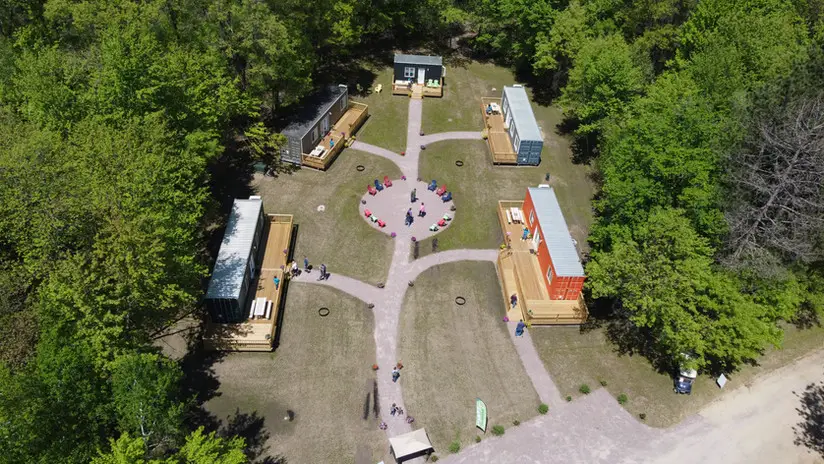
Basics of Tiny House Container Villages
Tiny House Container Villages are innovative residential ecosystems that effectively leverage the durability and modularity of shipping containers to create sustainable and often portable living spaces.
Understanding Tiny Houses
Tiny houses prioritize efficient use of space and resources, resulting in a smaller ecological footprint. They are typically defined by their size, usually less than 400 square feet, making them a symbol for minimalist and sustainable living. Recycled shipping containers have become a popular choice for these structures due to their robustness and stackability.
Evolution of Container Living
The concept of container living has evolved from the basic notion of reusing shipping containers for habitation to developing entire communities, known as tiny house container villages. These villages not only provide a compact and eco-friendly housing solution but also foster a sense of community among residents. The integration of containers into these villages showcases a creative approach to recycling and sustainability in modern housing.
Tiny House Container Village in Wisconsin Dells
Nestled in the heart of Wisconsin Dells, the Tiny House Container Village presents a unique vacation experience, combining eco-friendly practices with cozy accommodations at Yukon Trails Camping Resort. Spearheaded by Petite Retreats, this novel approach to lodging caters to those seeking a friendly and sustainable getaway.
Yukon Trails Camping Resort
Yukon Trails Camping Resort features an array of options for guests, but its standout attraction is undoubtedly the Tiny House Container Village. Here, visitors can unwind amid nature while enjoying the comforts of a modern, minimally intrusive residence. This initiative reflects an emerging trend in hospitality, with each tiny home being a transformation of a recycled shipping container, complying with green practices encouraged by organizations like the U.S. Green Building Council.
Petite Retreats and Tiny House Village Experience
Petite Retreats oversees the Tiny House Container Village, ensuring that each tiny house is not only comfortable but also meets high standards of sustainability. This innovative vacation concept merges the allure of the rustic wilderness with the practicality of green living, providing guests with an eco-conscious travel choice. The village fosters a friendly environment, inviting travelers to immerse themselves in the unique culture and recreational activities that Wisconsin Dells offers.
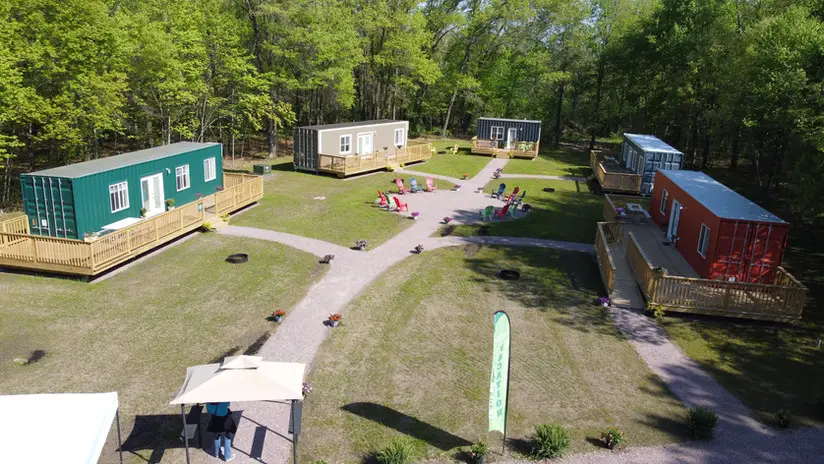
Design and Architecture
The transformation of shipping containers into habitable spaces is an innovative movement in the world of architecture, combining design prowess with efficiency. These habitats, often referred to as container homes, have evolved substantially, exhibiting both form and function through their unique construction.
Innovative Use of Shipping Containers
Shipping containers have become the backbone of modular villages, featuring an aesthetic that’s both industrial and minimalist. Containerwerk, Germany, has pioneered in this realm, developing villages where each container retains its original structure while sporting facades of regional, untreated wood. This approach not only reinforces sustainability but also ensures a smooth visual transition from nature to the container’s inherent metallic features.
Maximizing Space Efficiency
The interior of these homes exemplifies the art of space efficiency. With the inclusion of fold-out or multi-use furniture, these tiny homes offer full kitchens and bathrooms without compromising square footage. Companies such as S.I. Container Builds, Inc. focus on optimizing the small living space to ensure residents have all the comforts of a traditional home, including glamping-style accommodations that emphasize luxury in compact living. As a result, the carbon footprint of these homes is greatly reduced compared to that of standard construction, aligning with a growing societal emphasis on environmental efficiency.
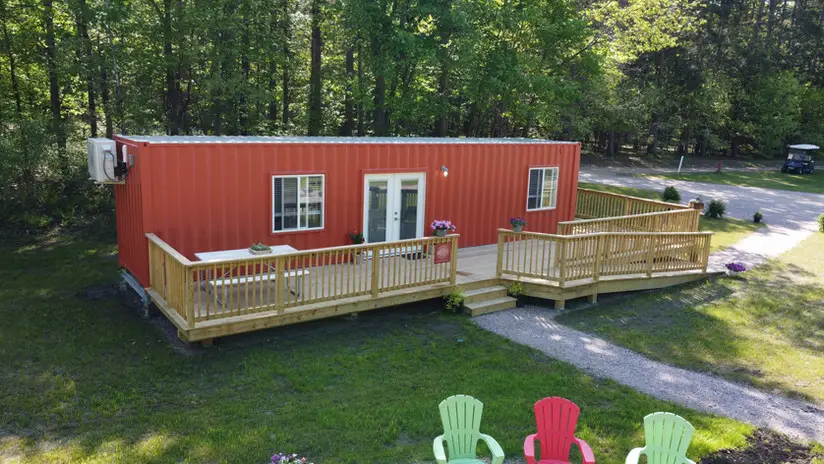
Amenities and Features
Tiny house container villages offer a blend of rustic charm and modern convenience, nestled within picturesque landscapes. Now, let’s explore the specific amenities and features that contribute to an unforgettable experience.
Natural Surroundings and Scenic Beauty
Tiny house container rentals are strategically placed to maximize the enjoyment of natural surroundings. Guests can unwind among large pines and massive oak trees, which contribute to the area’s scenic beauty. These natural elements provide a tranquil and refreshing environment, often accompanied by designated spaces such as individual patios for personal reflection or social gatherings.
Accommodation Options and Comfort
When it comes to accommodation options, these villages boast a variety of unique accommodations. Each tiny house container rental is designed with comfort in mind, ensuring a cozy yet functional living space. Modern amenities such as Wi-Fi are standard, allowing guests to stay connected while enjoying the simplicity of tiny living. Accommodations are crafted to utilize every inch of space efficiently, ensuring a comfortable stay without compromising on the luxurious feel of the getaway.
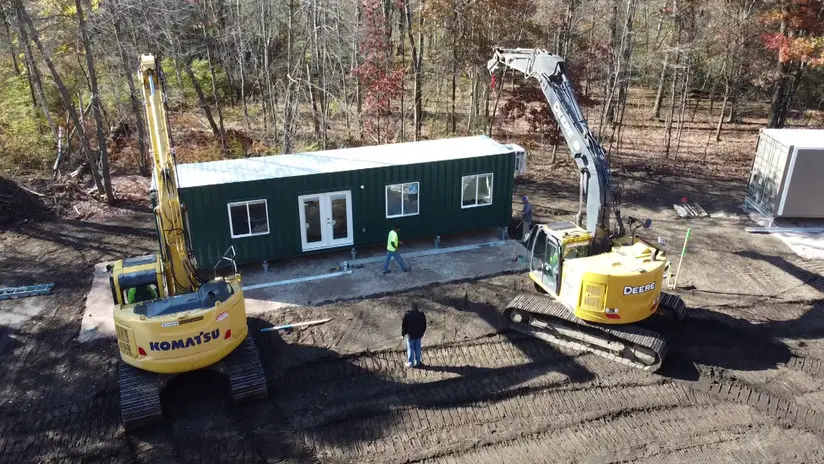
Sustainability and Conservation
Tiny house container villages are increasingly recognized for their commitment to sustainability and conservation. These eco-friendly communities not only cater to the minimalist lifestyle but also embody a profound respect for the environment through innovative green practices and endorsement by environmental groups.
Environmental Impact and Green Practices
The Tiny House Container Village at Yukon Trails Campground is a prime example of environmentally conscious accommodation. Located in Central Wisconsin, these unique rentals minimize their ecological footprint by repurposing shipping containers into charming tiny homes. Energy-efficient appliances and low-flow water fixtures are standard in each home, significantly reducing water and electricity consumption. Additionally, the village promotes family-friendly amenities that emphasize outdoor recreation and environmentally friendly experiences, encouraging guests to immerse themselves in nature without causing harm.
Endorsements by Environmental Groups
The conscious design and operation of the Tiny House Container Village aligns closely with the principles of conservation groups. Recognized for their commitment to environmental stewardship, projects like these often receive positive acknowledgment. Due to their strong alignment with sustainability goals, such as reducing waste through upcycling and maintaining low-impact tourism, these tiny house communities garner praise and serve as models for environmentally responsible living and tourism.
Lodging Beyond Tiny Houses
While tiny houses provide a quaint and efficient lodging experience, the realm of alternative accommodations offers a plethora of options for travelers seeking variety. These accommodations include yurts, cabins, cottages, and glamping tents, each tailored to deliver a unique vacation experience.
Alternative Accommodation Types
Yurts offer a circular structure that delivers a balance between the rustic and the modern, often featuring amenities like insulation, windows, and wooden floors. Cabins, on the other hand, merge the traditional rustic charm with modern comforts, ideal for those looking for a home-like environment amidst nature.
Cottages are reminiscent of picturesque storybook settings, providing a cozy retreat often near water or nestled in woodland areas. They typically feature full kitchens, baths, and one or more bedrooms, appealing to families and couples alike.
For a more elevated camping experience, glamping tents incorporate luxury into the classic camping experience, often equipped with the same amenities found in hotels, such as comfortable beds and en-suite bathrooms.
Lastly, RV resorts cater to the nomadic spirit, offering the facilities for RV travelers to park and connect their vehicles to various utilities, while also often boasting additional comforts like pools, clubhouses, and social activities.
Partnerships with Local Vendors
These unique vacation rentals often establish partnerships with local vendors to enhance the guest experience. For instance, a tiny house container village near the action-packed Wisconsin Dells not only offers proximity to outdoor recreation but also connects guests with local attractions and activities.
Similarly, accommodations in places like Sedona might collaborate with local tour guides to provide exclusive hiking tours or with wellness centers for rejuvenating spa services. These partnerships are a boon for visitors seeking an authentic experience in their chosen destination, immersing them in the local culture and natural beauty.
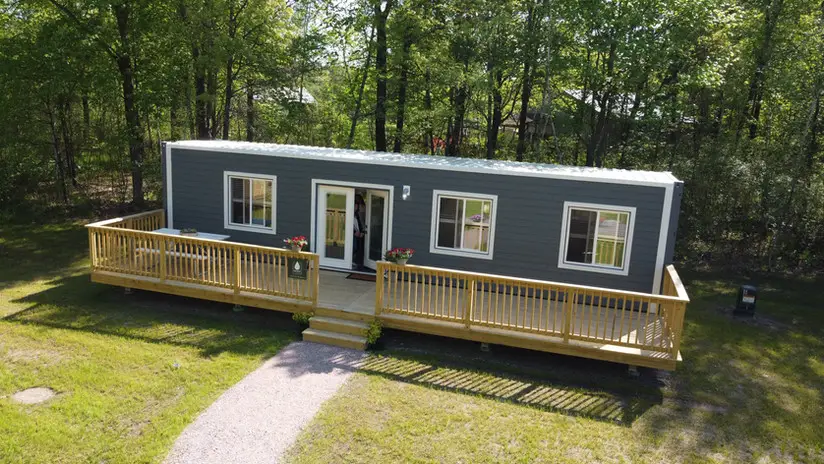
Recreational Activities and Attractions
The Tiny House Container Village offers an array of recreational activities and attractions that cater to both adventure enthusiasts and those seeking cultural engagements. Visitors can immerse themselves in outdoor activities suited for the whole family or partake in local community events that showcase the area’s heritage and charm.
Outdoor Adventures and Family Activities
Hiking: For those who love to explore nature on foot, the proximity of the tiny homes to varied hiking trails allows guests to embark on scenic treks through lush forests and alongside babbling brooks.
Water Activities: Guests eager for aquatic adventures will find plenty of opportunities for swimming and rafting in the nearby rivers and lakes. The region’s crystal-clear waters provide a refreshing retreat during warmer months.
- Family Sleeps 4: Each tiny home comfortably sleeps four individuals, making them an ideal base for families seeking both adventure and rest.
Cultural and Community Events
Open House Event: Potential visitors should mark their calendars for planned open house events, such as the upcoming tour on Saturday, May 20, 2023, which offers a chance to experience the unique charm of the Tiny House Container Village firsthand.
Visitors can engage with the local community through a calendar of cultural events that reflect the area’s vibrant heritage. Participating in these events allows visitors to connect with locals and gain a deeper appreciation for their destination.
Booking and Planning Your Stay
When planning a visit to a tiny house container village, it’s important to consider both the booking process and what the visit itself will entail. This ensures a seamless experience from start to finish.
Reservations and Availability
Booking: Reservations for a stay at tiny house container villages can typically be done online through each village’s own website. For example, guests interested in the Yukon Trails Tiny House Container Village can check availability and book their stay directly on the site. It is crucial to book well in advance as these unique accommodations can fill up quickly, especially during peak travel seasons.
Availability: Tiny house villages, like the Mount Hood Tiny House Village or the Natchez Trace Tiny House Village, offer a range of dates, but the specific availability will vary. To avoid disappointment, potential visitors should check the dates they wish to stay and secure their booking as early as possible.
What to Expect During Your Visit
Accommodations and Amenities: Visitors should expect well-equipped, compact living spaces that are fully furnished and include resort-style amenities. For example, the Leavenworth Tiny House Village boasts Bavarian-themed houses with amenities that may include kitchenettes, private bathrooms, and sleeping areas.
Site Facilities: Many tiny house container villages are part of larger resorts offering additional services. Verde Valley RV Resort provides visitors with a range of amenities such as fitness centers, swimming pools, and communal areas. Guests should expect a community feel with the option for privacy in their own tiny house.
Management: These villages are often managed by specialized companies, such as Equity Lifestyle Properties, Inc.. Their representative, Pat Zamora, highlights the appeal of tiny house living with the unique combination of simplicity and luxury.
Each village, including the Tuxbury Tiny House Village and the Sunshine Key Tiny House Village, offers a unique experience influenced by its location, so visitors should research what each site specifically offers to enhance their stay.
Frequently Asked Questions
In this section, readers can find concise answers to some of the most common inquiries regarding the costs, regulations, and features of converting shipping containers into livable spaces, as well as information on tiny house container villages.
What are the average costs associated with converting a shipping container into a livable tiny house?
The average costs for transforming a shipping container into a tiny home can vary greatly, typically ranging from $10,000 to $35,000, depending on the level of customization and finishes desired.
How do container homes compare in cost to traditional tiny homes?
Container homes are often more structurally robust than wooden tiny houses and may offer cost savings due to the inherent strength of the shipping container. However, the price can be comparable with traditional tiny homes when considering all modifications and furnishings.
What are the zoning regulations for setting up a container home in Tennessee?
Zoning regulations in Tennessee can differ by local governments, so it’s important to check with the relevant municipal or county offices. Generally, container homes must comply with building codes and zoning requirements, which could include permits and adherence to minimum size standards.
Where are some areas in Pennsylvania that are conducive to building a tiny house?
Areas in Pennsylvania that are favorable for building tiny houses include rural and suburban regions where zoning laws are more accommodating. Prospective builders should consult local ordinances and perhaps consider established tiny house communities for smoother transitions.
What amenities are typically available in a tiny house container village?
Tiny house container villages often provide a range of amenities including oversized bathrooms, multi-use furniture, and sometimes communal areas such as gardens or recreational spaces, all designed to create comfortable and efficient living.
Are there established container home communities in Atlanta or Florida?
Established container home communities are emerging in urban areas such as Atlanta, offering modern amenities within the container homes. In Florida, the trend is also gaining popularity, with communities focusing on sustainable living and efficient use of space.
